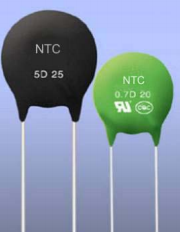Variable Resistor
A variable resistor is a resistor whose value is variable.many factors can induce a variation of R according to its constitution.
The most common are the following factors:
Mechanical: Most often a variation in the length of the resistant body. These are strain gauges, Potentiometers or Rheostats.
Thermal: The temperature to which the resistance is subjected (thermistor).
We can find the Positive Temperature Coefficient resistance (the resistance increases when the Temperature increases) and the Negative Temperature Coefficient (the resistance decreases for an increase in T).
Radiation: The radiation to which the resistance is subjected. (Many models exist, each one is sensitive to a specific radiation range).
Chemical: A substance (gas, liquid, solid) brought into contact with the resistance.
Electrical: the varistor is a resistor whose value drops from a threshold voltage.
NTC Thermistors
Thermistors or resistors with negative temperature coefficient or NTC:
They are manufactured with semiconductor oxides. The relationship between the resistance of a NTC and the temperature of the NTC resistor is approximately R = A.e ^ (B / T) where A and B are characteristic component constants.
PTC thermistor
Positive temperature coefficient (PTC) resistors: They are characterized by a very sudden variation in their resistance at a given temperature. They can be used for:
• protection devices against overheating
• varistors or VDR resistors (Voltage Dependent Resistor):
They
consist of an agglomerates of silicon carbide crystals. It is a resistor whose
value depends on the value of the applied electric voltage. They come in the
form of sticks or discs.
Photoresistors (LDR)
Photoresistors or LDR (Light Depending Resistors): These are cadmium sulphide-based resistors which have a small transparent window and whose value varies depending on the lighting, usually from 75 to 300 Ω for 1000 lux to some 10 MΩ in the dark.
The two
best known types are LDR03 and LDR05 which differ only in their connection
wires.
Varistors (VDR)
Varistors
or VDR: These are resistors for which there is a non-linearity between the
electrical resistance and the applied voltage. The relationship between current
and voltage U = f (I) non-linear :
 |
| characteristic U = f (I) |
The main
applications are
• protection against overvoltage
• voltage stabilization
• expansion
of the reading scale of measuring devices
Potentiometer
Potentiometers are widely used in electronics.There are rotary potentiometers, but also rectilinear potentiometers in which the contact moves in a straight line.
A potentiometer is a resistive element with three terminals:
• Two correspond to the ends of the resistance body,
• The last corresponds to the cursor which can move on the body of the resistance.
There are
several kinds of potentiometers depending on the variation in resistance due to
displacement of the contact.
If the
resistance is proportional to the displacement, the potentiometer is said to be
linear (type A)
But we also manufacture logarithmic variation potentiometers (type B).










Comments
Post a Comment